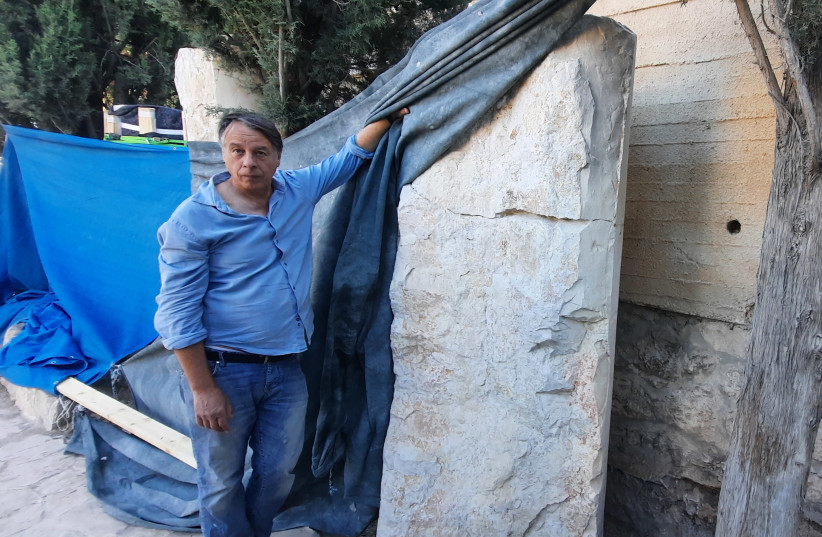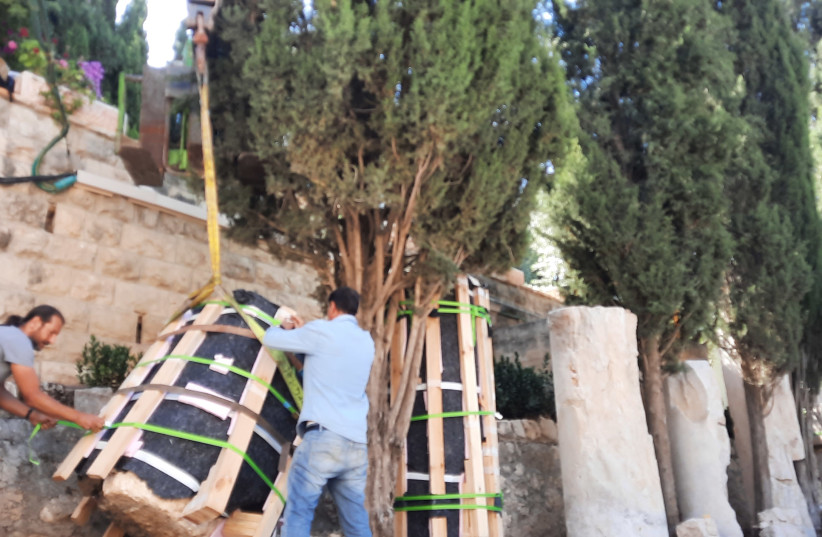After almost a year of preparation and planning, a complex operation saw two ancient Corinthian capitals and six pieces of two monumental columns (once part of the colonnade around the Aedicule in the Church of the Holy Sepulcher) moved to the archaeology wing of the Franciscan Terra Sancta Museum in the Old City.
The museum is located on the grounds of the Church of the Flagellation, which is close to Lions’ Gate. Two other capitals from the Church of the Holy Sepulcher – and the original Franciscan baptismal font – are already at the museum.
The architectural elements were discovered in 1969 during major restoration work of the Anastasis, where the Aedicule – revered by Christians as the tomb of Jesus – is located. They were found inside a wall in the northern side of the Church of the Holy Sepulcher, belonging to the Franciscan Custody of the Holy Land.
The Greek Orthodox, the Catholic Franciscan Custody and the Armenian Orthodox are the three main denominations sharing sovereignty rights in the Church of the Holy Sepulcher.
The wall was built during the British mandate period to replace the colonnade, which had become fragile over time. After a brief sojourn in the esplanade of the entrance to the Basilica, the pieces were moved to the hermitage garden in the Church of Gethsemane.

As the architectural elements barely withstood the ravages of time – including a fire, an earthquake, and many years of exposure in the hermitage garden – moving them required careful planning, said restoration expert Pietro Coronas. He led a team of five Italian restorers and conservators from the Italian NGO Restorers Without Borders, working in conjunction with the Pro Terra Sancta NGO, which initiated the project.
The columns
The columns were used as a model for the contemporary reconstruction of the colonnade, though it is not known if the rest of the colonnade used the same type of columns, Pro Terra Sancta noted in a report. In addition, they said, the capitals were too damaged to serve as a model for reconstruction; capitals from the Byzantine-era church, located in what is now the Kursi National Park, were used instead.

The column pieces at Gethsemane needed to be freed from the cement base that had been used to stabilize them 53 years ago. The restoration experts cleaned the pieces using a special organic mixture, which included oregano and was developed for use in the Vatican museums. The team also conducted a 3D scan and used thermography technology to identify cracks in the marble, some of which were invisible to the naked eye. Thermography detects cracks by measuring the temperature variations on the surface of the stone, which will be colder in places where fissures have developed.
Coronas said U-shaped metal rods had been inserted in some places in the columns to better secure them.
“We decided not to conceal all the fissures because this is part of the history of the column,” he said. “In the museum, it will be nice to tell the story and show also the damage they have suffered.”
“In the museum, it will be nice to tell the story and show also the damage they have suffered.”
Pietro Coronas
Still, he said the fissures made the stone quite weak and presented the greatest challenge for the experts.
“Our first challenge is not to break the columns,” said Coronas. “We don’t want to lose any piece.”
He said the pinkish-veined marble is most likely from a local quarry.
In addition to the cracks, the team also discovered ancient graffiti on the columns, including initials and crosses carved into the marble. Pointing to a section of a column piece, he said that remains of ancient paint used on the column were miraculously still visible despite decades of exposure to the natural elements.
The exact age of the columns is not known, and some samples were taken from the marble for dating analysis. The experts believe they originally came from a Roman temple built over the place of Jesus’ burial during the reign of Emperor Hadrian (117-139 CE), but they actually may have been reused from King Herod’s time.
The pillars were likely again reused during the construction of the Church of the Holy Sepulcher in the 11th century during the Byzantine period, said Coronas.
Historical photos show that half a century ago, the pieces (which weigh several tons each) were moved out of the Old City by sheer animal and human power – moved on wooden rollers laid on the ground, said Vincenzo Zuppardo, architect of the Franciscan Custody.
“This is a very exciting project,” he said, as he watched the slow lifting of the first capital by Haifa forklift driver Mokles Hatib. “This is the first [element] we are moving. It is incredible but difficult. I will feel relieved when we get the first column set up inside the museum. Then, we will fully understand what we need to do.”
He said special structures had also been set up inside the museum to move the pieces and exhibit them in their permanent exhibition space in the new Sylvester Saller wing of the archaeological section.
Pro Terra Sancta project manager Sara Cibin said for this particular move, they had painstakingly searched for a company with the proper equipment strong enough to lift the heavy pieces, yet also small enough to maneuver the narrow streets of the Old City. The pieces are planned to be brought into the museum in stages through Lions’ Gate.
On Monday morning, the Italian team worked to finalize the security measures they had taken to protect the first of the two pieces to be lifted to the top terrace of the hermitage garden. Amid the team’s tensions, Hatib kept his cool.
The company he works for, Shai Magen Forklifts, specializes in unique cases, and he’s been doing this kind of work for 30 years, he said after completing the move of the first capital.
“I was here last week to look things over,” said Hatib. “When you plan ahead of time, then you know what needs to be done. This is the kind of work I like to do. They were nervous, not me. Everything will be okay.”
